Software News
FluoRender 2.5 Released
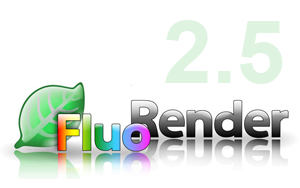 The FluoRender development team is pleased to announce the release of FluoRender 2.5. The new version has a number of new features. For details and downloads see the FluoRender Documentation page.
The FluoRender development team is pleased to announce the release of FluoRender 2.5. The new version has a number of new features. For details and downloads see the FluoRender Documentation page.
MRL Releases FEBio 1.2
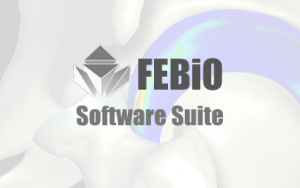 Febio 1.2.0 is now available for download. It includes several new features including:
Febio 1.2.0 is now available for download. It includes several new features including:- faster, multi-threaded linear solvers (Pardiso, SuperLU)
- contact improvements such as improved stability for large compression problems
- a new biphasic contact algorithm to simulate contact between two poroelastic materials
- new material models such as strain-dependant poroelasticity, Holmes-Mow elasticity, ...
As of this version, we will also be distributing our test and examples problems, which illustrate how to setup particular finite element models in FEBio. The testing and examples folders will be located in the installation folder.
Also, a new release of PostView (version 1.3) is now available. The GUI was completely redesigned to provide easier and faster access to the model’s data and properties. A number of improvements were made to the visualization tools as well.
Announcing VisTrails 1.4
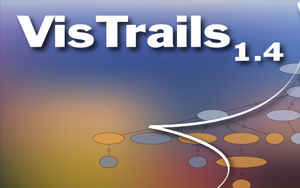 The VisTrails development team is pleased to announce the release of VisTrails 1.4. The new version contains quite a list of improvements and bug fixes. For details, see the release notes.
The VisTrails development team is pleased to announce the release of VisTrails 1.4. The new version contains quite a list of improvements and bug fixes. For details, see the release notes.Download Now
Advanced Climate Change Visualization Presented at UN Climate Change Conference
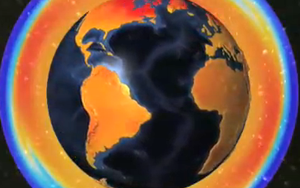 The VACET Center played a key roll in the production of the following visualization of historical and projected climate change data that was presented to participants at the UN Climate Change Conference in Copenhagen in December of 2009. The animated series of temperature anomaly maps was produced by averaging results from 15 of the most advanced climate models in the world resulting in the best projection of climate change to the year 2100. The visualization was created using software integrated with ViSUS data streaming technology developed largely by Valerio Pascucci and techniques developed at the DOE VACET Center.
The VACET Center played a key roll in the production of the following visualization of historical and projected climate change data that was presented to participants at the UN Climate Change Conference in Copenhagen in December of 2009. The animated series of temperature anomaly maps was produced by averaging results from 15 of the most advanced climate models in the world resulting in the best projection of climate change to the year 2100. The visualization was created using software integrated with ViSUS data streaming technology developed largely by Valerio Pascucci and techniques developed at the DOE VACET Center.For more information about ViSUS see: ViSUS: Visualization Streams for Ultimate Scalability.
ParaView Now Includes the VisTrails Provenance Plugin
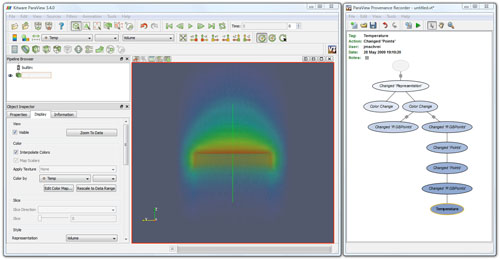 Kitware, Sandia National Laboratories and Los Alamos National Lab have released ParaView 3.6.2. The latest release now includes the VisTrails Provenance Explorer plugin in the Windows and Linux packages. VisTrails is an open-source scientific workflow and provenance management system developed at the SCI Institute that provides support for data exploration and visualization.
Kitware, Sandia National Laboratories and Los Alamos National Lab have released ParaView 3.6.2. The latest release now includes the VisTrails Provenance Explorer plugin in the Windows and Linux packages. VisTrails is an open-source scientific workflow and provenance management system developed at the SCI Institute that provides support for data exploration and visualization. Announcing VisTrails 1.3 and 1.2.2
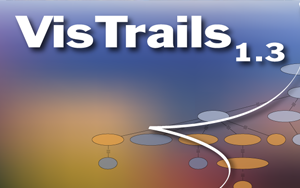 The VisTrails development team is happy to announce the release of two new versions of VisTrails. Version 1.3 contains lots of new features, improvements and a new version of the user's guide. Version 1.2.2 contains lots of bug fixes and it's basically a maintenance release of version 1.2.1. Both versions come with updated versions of VTK (5.4.2) and matplotlib. For a more detailed description see the release notes below. Both versions may be downloaded from the VisTrails wiki.
The VisTrails development team is happy to announce the release of two new versions of VisTrails. Version 1.3 contains lots of new features, improvements and a new version of the user's guide. Version 1.2.2 contains lots of bug fixes and it's basically a maintenance release of version 1.2.1. Both versions come with updated versions of VTK (5.4.2) and matplotlib. For a more detailed description see the release notes below. Both versions may be downloaded from the VisTrails wiki.
SCI and Moran Eye Center Collaboration Completes Map of Eye Neurocircuitry
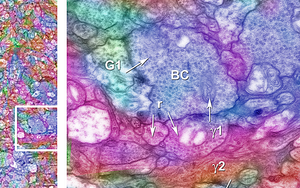 A SCI research team, lead by Dr. Tolga Tasdizen and Dr. Ross Whitaker, in collaboration with Dr. Robert Marc and his team at the Moran Eye Center have recently completed a 3D neurocircuitry map of every cell in the retina of a rabbit's eye. This data is a huge milestone on the way to building a complete description of the neurocircuitry that allows mammals to see. By comparing healthy samples with those undergoing disease processes, neuroscientists hope to develop a detailed understanding of how many diseases cause blindness and hopefully find ways to stop or even reverse the deterioration. The Neural Circuit Reconstruction Toolset used to construct this unprecedented map from thousands of individual electron microscope images was developed here at the SCI Institute and is currently available for download for free. The massive 20GB dataset will also eventually be made available on the web.
A SCI research team, lead by Dr. Tolga Tasdizen and Dr. Ross Whitaker, in collaboration with Dr. Robert Marc and his team at the Moran Eye Center have recently completed a 3D neurocircuitry map of every cell in the retina of a rabbit's eye. This data is a huge milestone on the way to building a complete description of the neurocircuitry that allows mammals to see. By comparing healthy samples with those undergoing disease processes, neuroscientists hope to develop a detailed understanding of how many diseases cause blindness and hopefully find ways to stop or even reverse the deterioration. The Neural Circuit Reconstruction Toolset used to construct this unprecedented map from thousands of individual electron microscope images was developed here at the SCI Institute and is currently available for download for free. The massive 20GB dataset will also eventually be made available on the web.
VisTrails Provenance Explorer for Maya Wins Utah Innovation Award
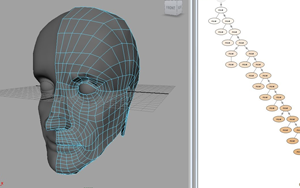 Congratulations are in order to the VisTrails team. Their Provenance Explorer for Maya has won the Utah 2009 Innovation Award.
Congratulations are in order to the VisTrails team. Their Provenance Explorer for Maya has won the Utah 2009 Innovation Award.VisTrails Inc., a SCI spin off company, was one of just nine companies to be awarded a Utah Innovation award for 2009. This award is designed to recognize Utah companies that make important innovations in their industries. A committee of more than 70 experts from private industry, government and higher education selected the award winners. Vistrails, Inc. was recognized in the Enterprise B-2-B Software category for it's Provenance Explorer for Maya.
For more information see: SL Tribune - "Utah's innovative spirit on display in Salt Lake City"
FEBio Profiled in BioMedical Computation
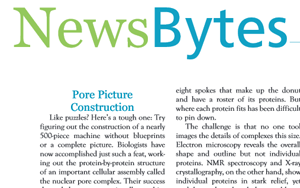 FEBio software profiled in Spring 2008 issue of BioMedical Computation. Download the pdf here
FEBio software profiled in Spring 2008 issue of BioMedical Computation. Download the pdf here
Announcing VisTrails 1.0
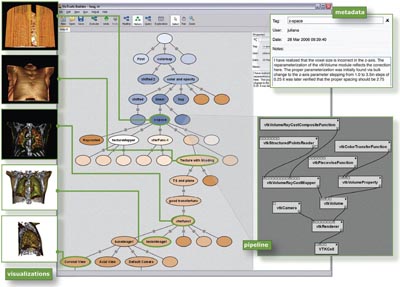 Fig 1: The VisTrails history tree contains a node for each version of a workflow (or pipeline) as it evolves over time. This results in a complete audit trail of the steps that were taken in a computational task. |
MRL Releases FEBio 1.0 Software Suite
 The Scientific Computing and Imaging Institute and the Musculoskeletal Research Laboratories are proud to announce the 1.0 release of the software FEBio, "Finite Elements for Biomechanics". FEBio is a nonlinear finite element software package that is specifically designed to address problems in computational biomechanics. Some of the features of note include capabilities for contact, rigid bodies and kinematic joints, nonlinear anisotropic constitutive models, simulation of active contraction, poroelasticity, element formulations for nearly-incompressible materials and parallel solution of the linear system of equations. After extensive testing in our lab and with our collaborators, we are happy to offer this free software to the research community. FEBio is currently available for WindowsXP, MacOS/X, Suse Linux (64 bit Opteron/Athlon64) and SGI Altix (64 bit Itanium2). We would be happy to port FEBio to other Unix/Linux platforms. The FEBio distribution includes the User's Manual, Theory Manual and several test problems to verify proper operation.
The Scientific Computing and Imaging Institute and the Musculoskeletal Research Laboratories are proud to announce the 1.0 release of the software FEBio, "Finite Elements for Biomechanics". FEBio is a nonlinear finite element software package that is specifically designed to address problems in computational biomechanics. Some of the features of note include capabilities for contact, rigid bodies and kinematic joints, nonlinear anisotropic constitutive models, simulation of active contraction, poroelasticity, element formulations for nearly-incompressible materials and parallel solution of the linear system of equations. After extensive testing in our lab and with our collaborators, we are happy to offer this free software to the research community. FEBio is currently available for WindowsXP, MacOS/X, Suse Linux (64 bit Opteron/Athlon64) and SGI Altix (64 bit Itanium2). We would be happy to port FEBio to other Unix/Linux platforms. The FEBio distribution includes the User's Manual, Theory Manual and several test problems to verify proper operation.




